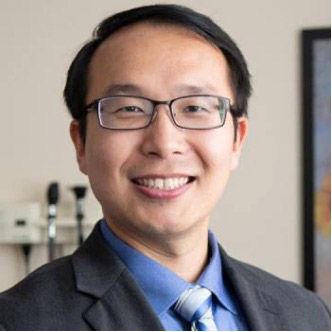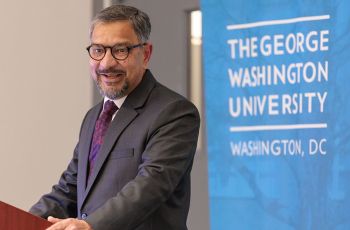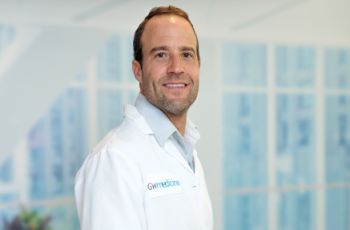James Rao's toolbox is filled with some of the most technical devices medicine has to offer. As one of the GW Cancer Center's radiation oncologists, Dr. Rao may perform stereotactic radiosurgery on one patient and brachytherapy on the next. His goal is to be as minimally invasive as possible and to preserve the organ being treated for cancer. On his off time (Is there ever any off time?), he spends time with his family and manages to coauthor children's books with his wife.

What’s your story?
I was born in Hunan, China, and came to the United States with my parents when I was in kindergarten. The first place we landed was North Dakota. My father was a physician in China. Here in the U.S., he worked in research and retrained as a gastroenterologist. We moved several times and ultimately ended up in Richmond, which is where I did most of my growing up. I went to high school and college there. I studied biomedical engineering and physics at Virginia Commonwealth University. My father sparked my interest in medicine, but the technology was what I found most interesting.
When I started medical school at Washington University (St. Louis), I explored several specialties. Still, I kept coming back to radiation oncology because this field has the coolest technology in medicine, with linear accelerators for treating cancer and different imaging modalities. Perry Grigsby, who was the chief of brachytherapy, was my primary mentor.
When I started looking for a job after completing my residency, Dr. Sharad Goyal was looking to bring someone in to start a brachytherapy program. I wanted to return to the East Coast, and the GW Cancer Center offered a wonderful opportunity to do exciting and fulfilling work. So, here I am!
What gets you out of bed in the morning?
My team here at the GW Cancer Center is amazing. I really like working with Drs. Goyal and Ojong, who are also radiation oncologists, and Dr. Chen, a physicist. We’re a really tight and close-knit team, and we get to work with some of the best technology out there. The ultimate goal is to help people by treating their cancer as minimally as possible. For example, with larynx (voice box) cancer, we can treat the cancer with radiation instead of surgical resection, and, in many cases, we’re able to preserve the organ and, often, the patient’s ability to speak and swallow normally.
On a personal note, I’m motivated by my family. My wife is a PhD student at GW, researching biomedical engineering with a focus on prostate cancer, prostate cancer imaging, and artificial intelligence. I’ve been lucky enough to work with her on some of her research projects. She’s helped me with some of my research projects, too. We have two sons, ages three and one. Those two keep us very busy!
What is that one book that has influenced you the most?
You may have heard of this one: The Emperor of All Maladies by Siddhartha Mukherjee. It’s the best book about the history of oncology ever written and one of the best medical books out there. It walks you through the field of oncology in many different eras, and the important thing to remember is that people were not less smart in the past. Very, very smart people in highly intelligent societies have been thinking about and treating cancer for thousands of years. The only major difference between people today and those of the past is that we now have more resources and technology. And we know more about cancer now. But those people were just as intelligent as we are today — they just didn’t have as much information and resources. Of course, I found the history of imaging methodologies and radiation treatments especially fascinating.
You and your work have made a difference for many patients. Is there one patient who made a difference for you?
Joy West comes to mind. The GW Hospital created a video about her, and she even wrote a book about her experience, 35 Days: Dancing in the Glow of the Light. Joy came to us with stage 3 larynx cancer and had some treatment choices, one of which included surgically removing her voice box. She couldn’t imagine life without her voice and opted for radiation therapy combined with chemotherapy. That meant she had 35 radiation treatments over a seven-week period. That’s a long time, but by giving low doses of radiation daily, we allowed her body to recover between each radiation treatment. And her laryngeal cancer was cured — her voice was preserved, which was her goal (along with becoming cancer-free). Today, Joy has an excellent quality of life: she’s able to breathe and swallow normally, and yes, her voice is excellent.
I have a copy of Joy’s book in my office. It tells the story of her cancer journey and the importance of staying optimistic. That’s important for people to know because too many people think a cancer diagnosis is a death sentence, and that’s not necessarily the case. In the right situations, we can cure many patients with radiation treatment. The other thing — Joy has the perfect name. It really was a joy working with her.
What is the most interesting thing we should know about you?
I am an avid collector and reader of historical books. Without a foundation in history, it’s difficult to understand how we got to where we are today, especially in terms of how we treat diseases and cancer. I actually have radiation textbooks from different decades, going back to the 1950s and earlier. It’s so interesting to see how the field has grown and developed over time.
Right now, I’m reading the history of World War II, written by Winston Churchill. I’m on the second book in a series of twelve. He was a prolific journaler and would record what happened each week. The second volume is called Their Finest Hour, and it’s about the invasion of France and Great Britain’s role as the last stronghold against the Germans. It reminds me that there have been dark moments in every era of history, really dark moments. Somehow, we manage to get through them to the other side, and the future gets better. That’s cause for optimism.
Another thing — my wife and I have written four children's books together called the Mallory Stories. They’re inspired by our Italian greyhound, Mallory. The books are geared toward young toddlers and tell stories about Mallory’s silly adventures, learning how to count, and getting a new sibling (this one was written when we were expecting our second child). One of the books is about Mallory exploring with dinosaurs, which I think is the kids’ favorite. They always roar when they see the T-Rex, which is a lot of fun for all of us.



